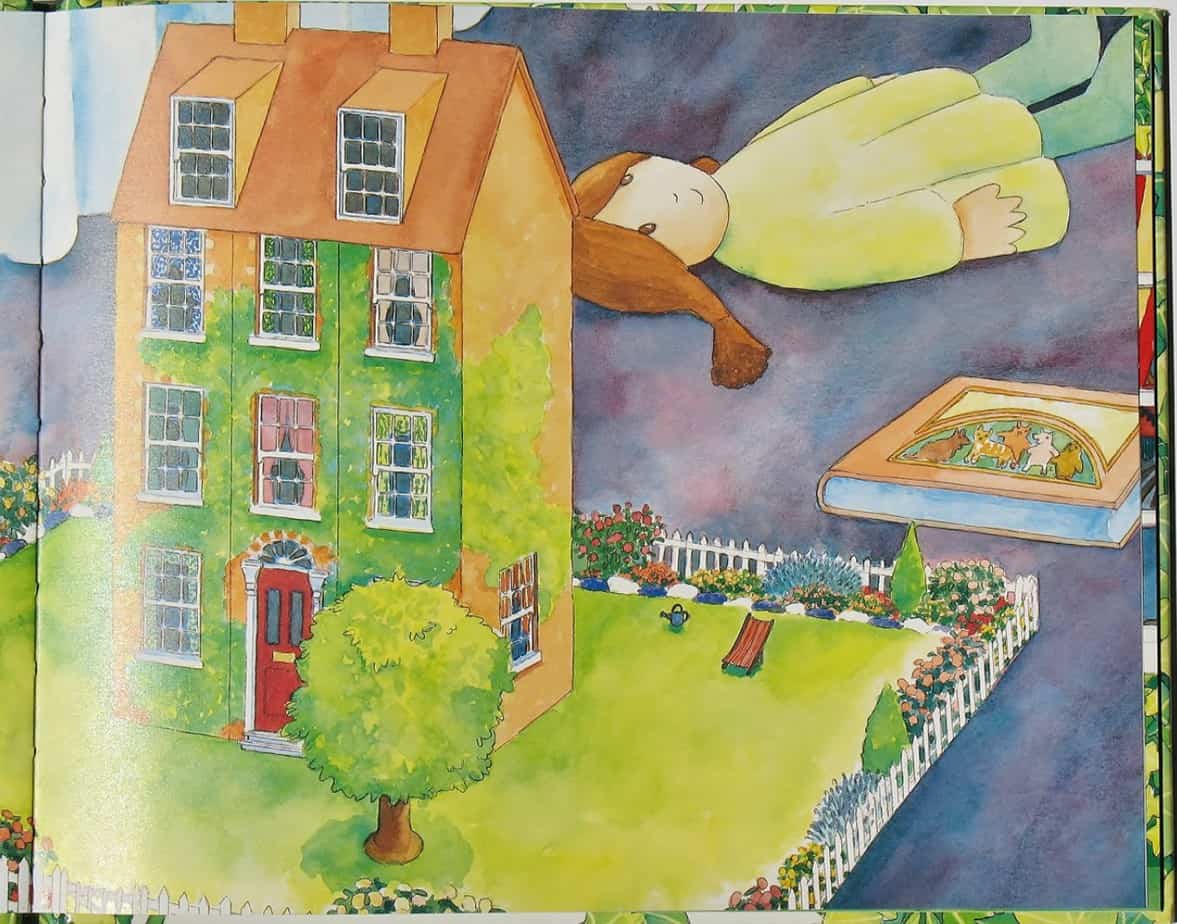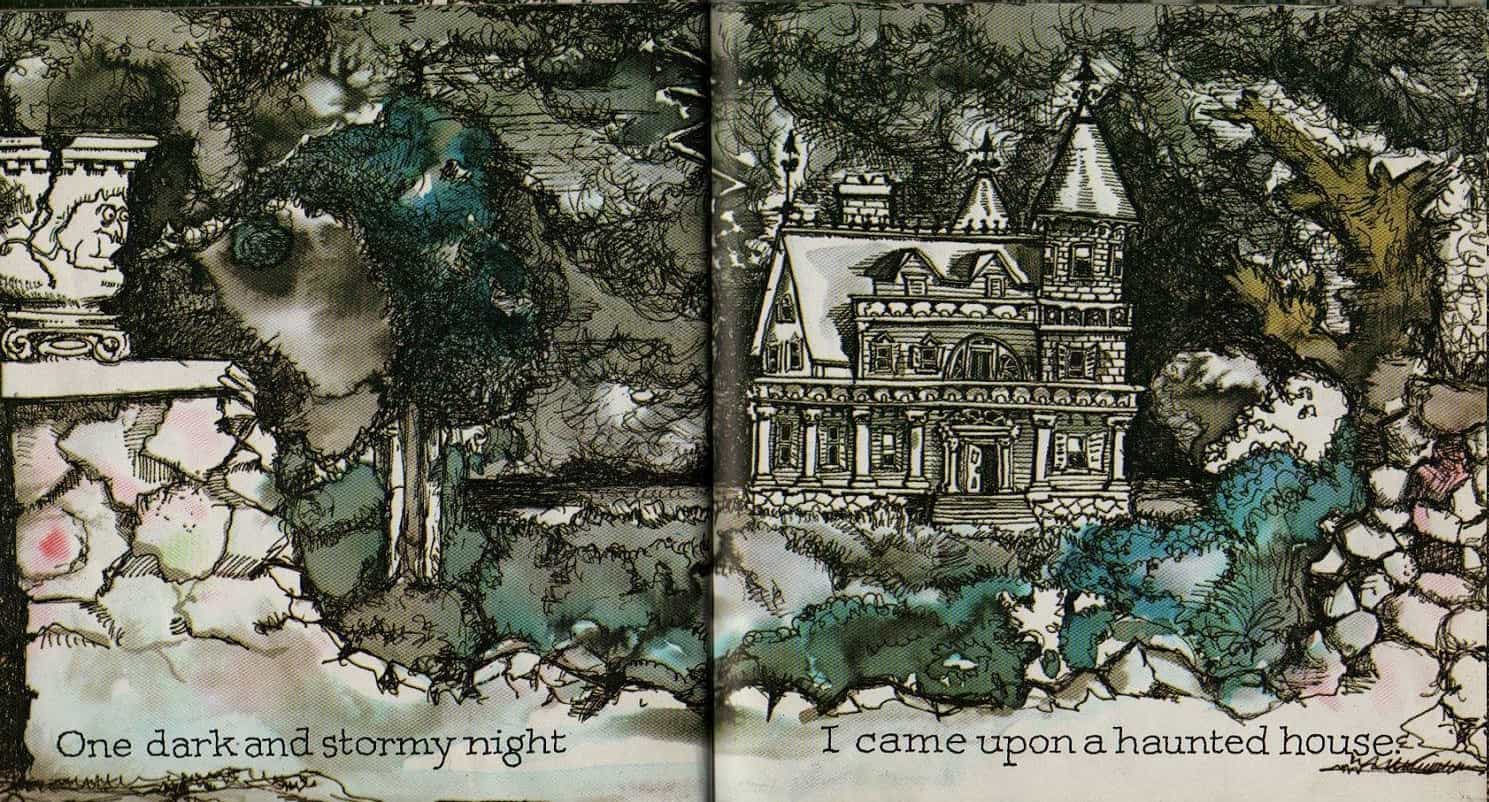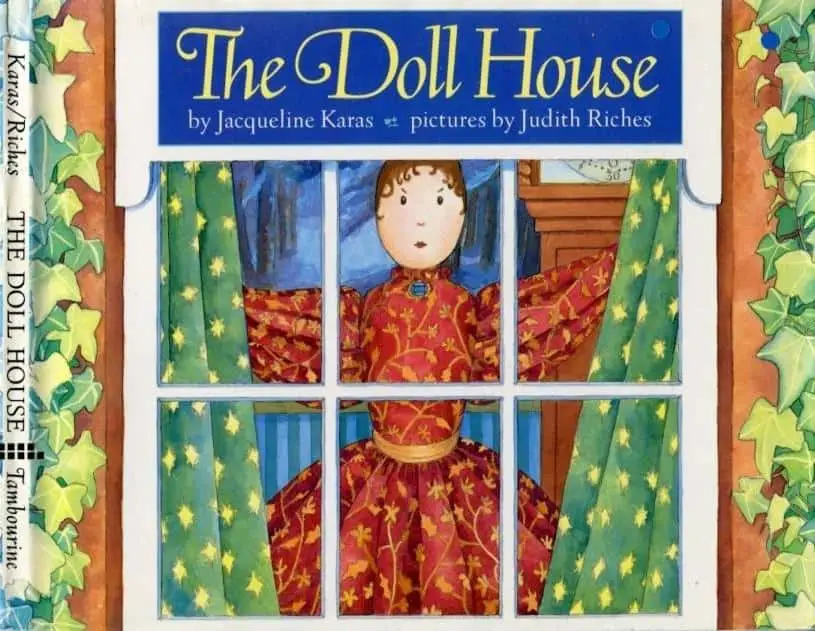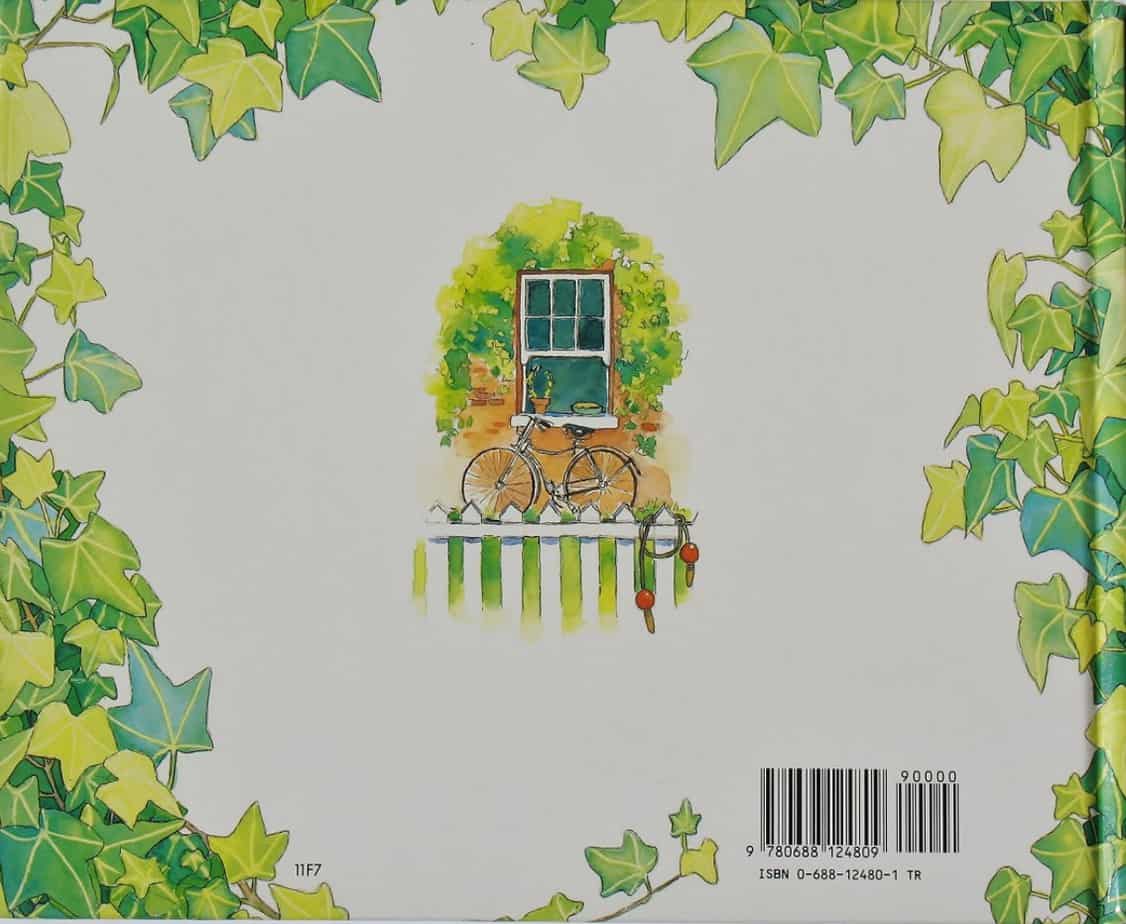The Doll House is a 1993 picture book written by Jacqueline Karas and illustrated by Judith Riches. Yesterday I took a close look at a short horror story by M.R. James called “The Haunted Dolls’ House” so today I thought I’d take a closer look at how picture book storytellers deal with the trope of the alive dolls in a cosy way, avoiding the horrific.
SETTING OF THE DOLL HOUSE
The first thing you notice is the beautiful, bright palette and watercolour bleeds. Even the darks are full of life.

Contrast this palette with the colours of a genuinely scary story, in which colours are muted as if seen through the darkness of night.

- PERIOD — contemporary (1990s, now feeling a bit dated, see below)
- DURATION — a few weeks or months
- LOCATION — There’s a mise en abyme effect to a doll house story — a house within a house. The doll house is inside a girl’s bedroom. There’s a single page close up of the bathroom plughole. Other than that, we don’t see the rest of the girl’s house, but we are afforded glimpses of the house next door and garden outside the girl’s own bedroom window, indicating suburbia. We know this is a Western story because the girl is sleeping in a Western style bed and has her own bedroom. The girl’s bed is high and has an iron bedhead, reminiscent of Victorian stories about haunted dolls’ houses. This is clearly a nod to the haunted dolls’ house stories of the Victorian era.
- ARENA — The girl’s house
- MANMADE SPACES — Just the girl’s house and her dolls’ house
- NATURAL SETTINGS — The dolls build a fence around the house to create a garden.
- WEATHER — The inside setting means the dolls can live with utopian weather. (It never rains inside.)
- TECHNOLOGY CRUCIAL TO THIS PARTICULAR STORY — The dolls’ house is impossibly detailed and is clearly the result of some kind of magic.
- LEVEL OF CONFLICT — We could read this story as a metaphor for colonialism. The girl chooses kindness and the dolls live their own lives separately but in harmony. When the boy cousin turns up he wreaks havoc on their home, using their things as if they were his own, and eventually drives them away. The girl is a bystander. In any case, this is a story about neighbour conflict. How do separate peoples learn to live peaceably side by side?
- THE EMOTIONAL LANDSCAPE — Alternatively, we could read this story as magic which happens only inside the girl’s head. The dolls’ house is so precious to her that she considers its inhabitants real. When the cousin ruins her order, he affects her so badly that she is no longer able to imagine they are alive.
STORY STRUCTURE OF THE DOLL HOUSE
PARATEXT
My Australian copy of this book is titled The Doll’s House (with apostrophe ‘sl) and I sometimes have no idea why publishers make the decisions they do! Perhaps there is a perceived dialect difference, or was, back in the early 1990s.
PreSchool-Grade 2
One morning, Alex wakes up and spies a doll family moving into her doll house. She slowly becomes friends with them, but when her cousin Martin comes for a visit and breaks some of their furniture, the Toy family moves, leaving a “for sale” sign on the front gate. Every day, Alex checks to see if someone new has moved in, and finally comes home from school one day to discover a “sold” sign. There the story ends. Having miniature toys come to life is an appealing idea to children, and anyone who has ever played with a doll house has undoubtedly hoped for it to happen. Readers can clearly envision the story through Riches’s well-defined watercolor illustrations. A gentle fantasy with just a bit of suspense and heartache, followed by the promise of a happy ending.
School Library Journal
SHORTCOMING
As in the horror short story by M.R. James, the girl and the boy are merely viewpoint characters. The real stars are the animated dolls who live inside the supernatural little house. Their weakness is that they are vulnerable. They basically have giants living right outside. Like the dolls in James’ novel, their facial expressions through the windows show that they are hostile to outsiders. We are not encouraged to empathise with them.
DESIRE
The dolls want to live in peace inside the dolls’ house, using the landscape of the girl’s bedroom as their entire world.
OPPONENT
After the girl (Alexandra) returns a lost shoe, the reader knows that Alexandra will be the dolls’ ally. The girl shows stereotypically feminine kindness.
The Minotaur opponent is the visiting boy.
The rambunctious boy who visits a girl’s house and destroys her girl toys is a gendered trope, though I admit it aligns with my own experience of girlhood. My own brothers were gentle with my toys and our mother encouraged ungendered play. But a disproportionate number of boy acquaintances of my childhood seemed hellbent on destruction of my things, while clearly showing interest in them. A ‘boys will be boys’ attitude still prevails. Girls are punished more severely for destruction.
PLAN
The boy is the character with the ‘plan’.
There’s nothing inherently violent and destructive about boyhood; rather, boys are shamed for showing girly interest in girls’ toys, because gender is a hierarchy with ‘boyish’ boys at the top. For some reason dolls’ houses are considered girls’ toys even though men and boys live in houses equally. Girls are praised for showing interest in cars and trucks, but if a boy would like to play with a fetching miniature house, the only way to do this without upsetting the gender binary status quo is to distance himself from the girl who owns the toy, and since kids don’t understand their own difficult emotions and motivations, one way a boy can distance himself from girly stuff is to upset a girl by upsetting her beguiling toys, otherwise completely off-limits to him.
This modern article encourages parents to gift doll houses to boys, in full awareness that boys love miniature things equallly. But notice how it lists a number of ‘boy’ options (pirate house, hero playhouse) which still encourage boys to stay away from anything that stinks of girliness. This division is great for toy manufacturers; any household with a son and a daughter now needs to double up on every single toy in the house (cf. Lego vs Lego Friends for a modern marketing success story.)
THE BIG STRUGGLE
The image of the doll house parts sitting in the plug hole is wretched. The hopes and dreams of the dolls have gone down the gurgler.
ANAGNORISIS
The girl realises that because of the boy, the dolls will move out.
She never realises her own part, as a bystander.
I would like to have seen Alexandra stand up to the cousin. The narrator says that because the boy is a visitor to the house, she must let him do as he pleases. This is the part of this 1990s book which feels dated. Today’s children are far more likely to request assistance when they see unfairness, and also far more likely to step in themselves. This is due to the shift that has happened in parenting and teaching. I’m sure anyone over 40 will remember incidents from childhood which would today be dealt with by adults. Children of yesteryear were told to go away and sort it out for ourselves.
There’s also a contemporary gendered ickiness to the idea that a girl must let a boy do as he pleases for the sake of etiquette. Layered onto that, the story takes place in her bedroom.
NEW SITUATION
This is a classic example of a repeating story structure. The ‘SOLD’ sign on the dolls’ house gate suggests a new family will be moving in and the story will repeat with minor variations.
EXTRAPOLATED ENDING
Next time her destructive cousin comes to stay I hope Alexandra will stand up for the dolls rather than letting him do as he pleases.
RESONANCE
There are many stories about dolls’ houses with live inhabitants, which are part of a larger subgenre of tales about miniature people and creatures living warily among the giants, who are us.


